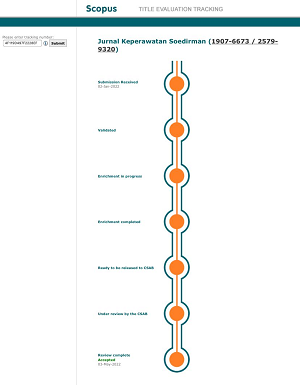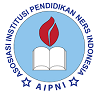|
|
|
Author Guidelines
Author Guidelines
Jurnal Keperawatan Soedirman
Download author guideline in English or Indonesia
Short description
Jurnal Keperawatan Soedirman is a scientific journal devoted to research and development publications in the field of nursing, such as surgical medical nursing, emergency, and critical nursing, nursing, maternity nursing, community nursing, gerontic nursing, nursing management, mental nursing, and other fields related. Articles can be original articles, systematic reviews, and meta-analyses in nursing fields.
Participants
Researchers from Universities, Research Institutes, and Hospitals.
Abstract and Indexer
Google Scholar
Crossref
Sinta
ISJD
Writing Guidelines
Coverage
Jurnal Keperawatan Soedirman includes research and developments in nursing fields, such as surgical medical nursing, emergency, and critical nursing, pediatric nursing, maternity nursing, community nursing, gerontologic nursing, nursing management, and other related fields.
Type of article
Jurnal Keperawatan Soedirman receives a full research article, and case study. Generally, the full research article and systematic review do not exceed 12 pages (3000-5000 words). The article should be written in English. A copy of institutional review board (IRB) approval is required for any research published in Jurnal Keperawatan Soedirman. The number of IRB approval should be provided in the methods section.
Journal Publishing Fee
Authors whose articles are approved for publication will be charged Rp. 3.000.000 (for Indonesian authors) and non-Indonesian authors may asking for APC waive by sending email to jks@unsoed.ac.id not more than a month after published. Two copies of the printout journal will be sent to the author.
Before the article is published, we will provide an author statement form that includes originality, not in process or published elsewhere, author agreements, no conflict of interest, and transfer of copyright rights. The statement form can be downloaded here. Please upload the document in the supplementary section.
Preparation of the Manuscript
The manuscript is written with word processing software (eg Microsoft-Word), for improved journal quality, articles preferably in English, typed in Arial Narrow 12 size font, 1.5 spaced density, on A4 size paper, with left and top borders 3 cm while the right and bottom edge of 2.5 cm.
Article Structure
The article structure used for primary sessions uses bold no-numbering (eg Abstract, Introduction), and more detailed sessions can use numbering 1,2, and 3 or a, b, and c.
Title
The title section consists of:
1. The title of the article (not exceeding 20 words).
2. Author's name and its affiliation (institution). The author responsible for the correspondence, marked "*", which is then under affiliation given the "*" email address"
Abstract
The abstract should be concise, maximum of 200 words, written both in Indonesian and English. The abstract contains a summary of the research's background, objectives, methods, key results, and main conclusions. It should be avoided writing libraries or citations in abstracts and abbreviated abbreviations.
Keywords
Keywords in Indonesian and abstract English, containing 3-5 keywords. It should be avoided the use of abbreviations and words can cause many perceptions. It should be chosen the right words so that people can find related articles by entering keywords in the search.
Background
The introduction contains the objectives and hypotheses of the study accompanied by appropriate rearranges. Detailed literature writing and the conclusion of research results should be avoided in this section.
Methods
This section contains tools and materials specifically used in the research as well as the workings of research methods undertaken. The workings that already existed in previous research, should be included in the reference and only modification if da which needs to be written in detail.
Results
Results should reveal and explain the results of the research that has been done in the form of tables or pictures obtained.
Discussion
The obtained result is then discussed by comparing it with the results of previous research. Other sources of references (of the previous research) are aimed at strengthening the argumentation of the results of research that has been done. The sources of references in the discussion must meet the scientific requirements (journal, textbook, or proceedings).
Conclusion and Recommendation
Conclusions from the results of research conducted delivered briefly and clearly
Acknowledgment
This section can be expressed thanks to institutions, experts, or other bodies that play an important role in the implementation of research undertaken.
Attachment
If necessary to deliver important supporting data, it can be attached in a separate session of the main article. Attachments can be video, images, computer simulation files, or data sets.
Math formula
Simple mathematical formulas should use a slash (/) to replace a horizontal line, for example, X / Y.
Picture
The displayed image or picture must be clear, at least 300 dpi resolution. Images created with programs such as Microsoft Word® or Microsoft Powerpoint® can be delivered as-is.
Image Title
The title is written underdrawings, middle averages, capital letters at the beginning of a sentence. Avoid unusual use of abbreviations. The title pointer of the image is thick (for example, Figure 1. Influence Z on Y under X).
Table
The table is given a horizontal line in the header (first row) and the end of the table only, with no vertical lines.
Table title
The title is written above the table, left flat.
Library
Type
80% referenced library is a journal (primary source) with a maximum age of 10 years.
Writing Library
Writing Library refers to APA (American Psychological Association) 6th edition. When using the library management software (Reference Manager), the style can be downloaded on each website:
Mendeley: http://csl.mendeley.com/
Example of writing
In writing
Single author
In one developmental study (Smith, 1990), children learned ...
or
In the study by Smith (1990), primary school children ...
or
In 1990, Smith's study of primary school children ...
Plural authors
The first citation: Masserton, Slonowski, and Slowinski (1989) state that ...
Next citation: Masserton et al. (1989) state that ...
Some references in a sentence
Several studies (Jones & Powell, 1993; Peterson, 1995, 1998; Smith, 1990) suggest that ...
Writing in the References
Book:
Strunk, W., & White, E. B. (1979). The guide to everything and then some more stuff. New York, NY: Macmillan.
Gregory, G., & Parry, T. (2006). Designing brain-compatible learning (3rd ed.). Thousand Oaks, CA: Corwin.
Book chapter:
Bergquist, J. M. (1992). German Americans. In J. D. Buenker & L. A. Ratner (Eds.), Multiculturalism in the United States: A comparative guide to acculturation and ethnicity (pp. 53-76). New York, NY: Greenwood.
Journal with DOI:
Fatoni, A., Numnuam, A., Kanatharana, P., Limbut, W., Thammakhet, C., & Thavarungkul, P. (2013). A highly stable oxygen-independent glucose biosensor based on a chitosan-albumin cryogel incorporated with carbon nanotubes and ferrocene. Sensors and Actuators B: Chemical, 185(0), 725-734. DOI:10.1016/j.snb.2013.05.056
Journal without DOI (DOI not available):
Hermawan, D., Yatim, I. M., Ab Rahim, K., Sanagi, M. M., Ibrahim, W. A. W., & Aboul-Enein, H. Y. (2013). Comparison of HPLC and MEEKC for Miconazole Nitrate Determination in Pharmaceutical Formulation. Chromatographia, 76(21-22), 1527-1536.
Hamfi, A. G. (1981). The funny nature of dogs. E-journal of Applied Psychology, 2(2), 38 -48. Retrieved from http://ojs.lib.swin.edu.au/index.php/fdo
Conference
Zusfahair, Ningsih, D. R., & Kartika, D. (2015). The potency of Amylase Producing Bacteria in the Liquid Waste of Tapioca Factory. Paper presented at the 1st Pharmacy International Conference, Purwokerto, Indonesia.
Online Newspaper:
Becker, E. (2001, August 27). Prairie farmers reap conservation's rewards. The New York Times. Retrieved from http://www.nytimes.com
Encyclopedia:
Brislin, R. W. (1984). Cross-cultural psychology. In R. J. Corsini (Ed.), Encyclopedia of psychology (Vol. 1, pp. 319-327). New York, NY: Wiley.
Submission Preparation Checklist
As part of the submission process, authors are required to check off their submission's compliance with all of the following items, and submissions may be returned to authors that do not adhere to these guidelines.
- The submitted manuscript has not been published before.
- Registered scripts are typed in Open Office or Microsoft Word document formats.
- If any URL address of the reference should be written.
- Text typed in single space; font 12; all-images, use italics instead of underscore (except the URL address); and all illustrations, drawings, and tables are placed according to positions in the text (not on separate pages).
- Writing styles follow the terms listed in the Author Guidelines
- If you register a section requiring peer review, Instructions in Ensuring a Blind Review are followed.
Copyright Notice
Privacy Statement
The names and email addresses entered in this journal site will be used exclusively for the stated purposes of this journal and will not be made available for any other purpose or to any other party.
Author Fees
Authors whose articles are approved for publication will be charged Rp. 3.000.000,00 or 200 USD. We offer waivers on the article publishing charges (APCs), sometimes known as article publication fees.
Who can request an APC discount or waiver for open published articles?
First authors and/or co-authors with primary affiliation in countries that are outside of Indonesia.
Requesting and applying an APC discount/waiver
- Check that you are eligible in the criteria for APC waivers
- Submit through the journal’s online submission system, add the application letter in discussion session or contact the editorial teams by sending an email to them.






.png)




_3.png)

 Kampus keperawatan unsoed
Kampus keperawatan unsoed  Published By Jurusan Keperawatan FIKES UNSOED
Published By Jurusan Keperawatan FIKES UNSOED jks@unsoed.ac.id
jks@unsoed.ac.id

